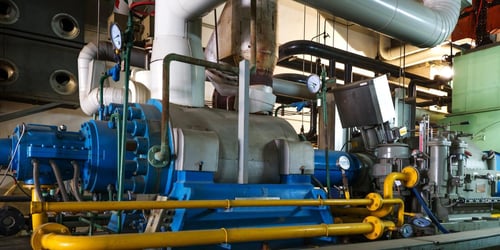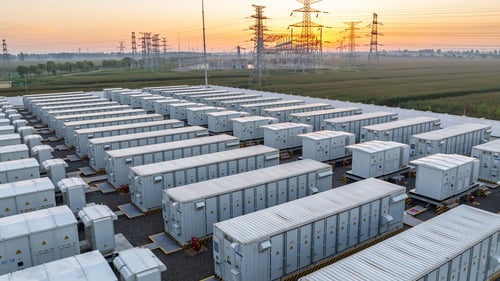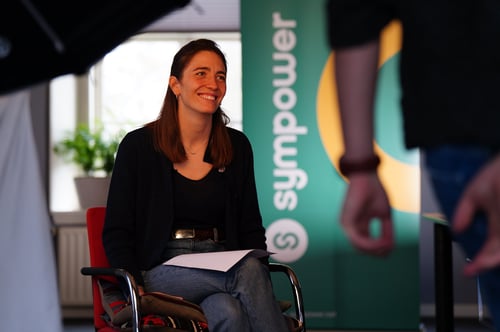EU elections: Opportunity or Risk for Demand-Side Flexibility? - Q&A with Mathilde Chareyron

Jump to:
- Explanation of the EU's political year in 2024
- The next Parliament's impact on demand-side flexibility
- Opportunities and risk for the energy transition
- The future of demand-side flexibility
- What Sympower advocates for and what is happening
Unlock New Revenue Streams with Demand Response
Check out our essential guide to energy flexibility.
2024 will be a pivotal political year for the European Union. Can you explain what’s happening?
It will be a busy year, with three different EU institutions seeing big changes. First, we’ll have the European elections in June, impacting all 27 member states, with a renewal of the European Parliament and new Members of the European Parliament (MEPs) coming in for the second half of 2024.
We’ll also see changes at the head of the European Commission, the body responsible for shaping the EU’s overall strategy and proposing new laws and policies. There will be a new college of Commissioners, with all countries nominating one commissioner each and a new president. Since many EU countries have recently had elections, we can expect changes among the Commissioners. Finally, we also expect a new president to head the European Council.
The European Parliament is known for its multi-party system, with no party having the absolute majority and a constant need for consensus between multiple parties. Once again, we’re likely to see a coalition of parties working together to drive decisions within the European Parliament.
The current set-up has been very favourable to promoting demand-side flexibility, and the Parliament has been ambitious in its approach. We’ve seen a revision of the electricity market directive, and the rapporteur Casares has directly promoted demand-side flexibility and worked closely with key partners such as smartEN. Centre-left parties have supported and pushed for a wider deployment of renewable energy sources.
The only thing lacking has been a stronger push for the transposition of directives nationally, so it would be great to gain this in the next parliamentary set-up, although it might be difficult to get.

The EU Commission has recently announced its commitment to reach 90% emission reductions by 2040. How will the next Parliament likely impact this environmental ambition and demand-side flexibility?
It’s hard to make specific predictions about what the next Parliament will look like, but we can expect an increase in right and far-right MEPs. We also expect many new faces, with nearly 60% of MEPs being completely new.
Historically, we’ve seen that more conservative parties are less ambitious regarding environmental and climate policies, with a tendency to set less ambitious targets and slow down reforms on the matter. However, regarding demand-side flexibility, there is no clear cut between what the left and right-wing parties would propose. There’s a reasonably clear consensus on the benefits of demand-side flexibility, which supports improved energy security and independence, better social benefits for all, and achieving a fair energy transition.
Demand-side flexibility also directly supports the decarbonisation of industries, a movement growing across Europe, without needing heavy upfront investment or public funding. It’s accessible to all countries, not just the Western European ones, so we hope to see renewed support from MEPs.
Which opportunities and risks do you foresee for the energy transition?
Overall, the outcome of the European elections will significantly influence the direction and pace of the EU energy transition. A Parliament supportive of ambitious climate and energy policies can accelerate progress towards a sustainable energy future, while a lack of consensus or political will could pose challenges and slow down the energy transition process.
Counting with a Parliament strongly supporting ambitious climate and energy policies would also mean more funding and resources to improve infrastructure and energy efficiency initiatives and enable greater policy alignment and cohesion amongst member states regarding goals and strategies.
Policies supporting the energy transition would also stimulate innovation and create new job opportunities in renewable energy sectors, contributing to economic growth and competitiveness. By supporting the decarbonisation of industries, countries would also strengthen the overall competitiveness of the European Union against other cleantech champions like China and the United States.
I mentioned earlier how demand-side flexibility improves energy security and independence; this is because it allows for better use of renewable energy sources. By diversifying energy sources and reducing dependence on fossil fuels, EU member states can increase their energy security, making them less vulnerable to geopolitical tensions and supply disruptions.
While this is all positive, we also foresee some risks for the future of climate and energy policies. If the election results lead to a fragmented European Parliament with conflicting views, this could hinder the EU’s ability to enact cohesive and effective legislation, slowing down the entire energy transition process.We also need to consider the lobbying influence from other energy actors who may attempt to influence policy decisions to protect their interests, which could undermine efforts to transition to a fully renewable energy system. Some industries, especially those heavily reliant on fossil fuels, may also express concerns about the economic impacts of a rapid energy transition. However, we also expect greater influence from all trade associations, including those favourable to the energy transition, such as smartEN, so lobbying efforts are not necessarily negative.
How do you see the future of demand-side flexibility?
Again, it will all depend on what the European Parliament will look like and also how MEPs can influence the transposition of EU directives nationally. A forward-thinking and ambitious Parliament can achieve much for the future of demand-side flexibility.
MEPs can shape the regulatory framework and push for regulations facilitating the participation of demand-side resources in electricity markets, a level playing field, and streamlined market access for demand response providers. They can also advocate for greater cooperation and harmonisation of policies across member states and the integration of demand-side flexibility into broader international energy initiatives.
They can also influence the allocation of European funds and support for energy projects and initiatives demonstrating the value of demand-side flexibility in improving grid flexibility and reliability. This kind of investment would support Europe’s competitiveness and increase critical technology manufactured locally, both factors likely to appeal to more conservative parties.
Also, let’s not forget that MEPs are very well integrated within their own country and can be a bridge between the EU and national implementation. They have a platform to raise awareness about the benefits of demand-side flexibility and educate national policymakers, stakeholders and the general public.
What does Sympower advocate for and what do we want to see happening?
First, we want to see the harmonisation of the framework for demand-side flexibility within the EU and a proper transposition of the Electricity Market Design, with a stronger push for a harmonised framework during the elections.
We also want to see increased awareness of demand-side flexibility and its benefits. We’ve definitely seen more mentions of demand-side flexibility in the last few years, primarily because of the increased need for a more robust grid. Policymakers are increasingly aware that modernising and strengthening the grid will cost a fortune, but that flexibility in general, and demand-side flexibility in particular, are ideal mechanisms to solve this challenge.
We want to accelerate and increase this awareness to ensure that we bridge the gap between EU legislation and national implementation. All the member states will have to review their flexibility needs and capacity and develop a plan. The current framework is, in theory, great at the EU level, so now the challenge is translating it practically for every country.
Independent aggregation should be allowed to get maximum flexibility in the markets. For demand-side flexibility technologies to become more prevalent, national legislation must support and improve the market entry of independent aggregators to offer an essential route into European electricity markets for owners of flexible assets.

Other articles you might find interesting
-
 Demand-side flexibility7 May 2024
Demand-side flexibility7 May 2024District Heating Operators: New Revenue From Grid Balancing
Read more -
.png?length=500&name=Untitled%20design%20(2).png) Energy transition7 May 2024
Energy transition7 May 2024Our Take on the Clean Industrial Deal - Why Everyone Agrees that Energy Flexibility is at the Heart of Europe's Energy Transition
Read more -
 Demand-side flexibility7 May 2024
Demand-side flexibility7 May 2024Five Myths About Demand Response, Debunked!
Read more -
 Demand-side flexibility7 May 2024
Demand-side flexibility7 May 2024BESS & Demand Response, What’s the Connection?
Read more -
.jpg?length=500&name=Article%20Thumbnails%20-%201920x1080%20new%20website%20(4).jpg) Demand-side flexibility7 May 2024
Demand-side flexibility7 May 20243 Things to Look for in a Flexibility Service Provider
Read more -
 Energy transition7 May 2024
Energy transition7 May 2024How Strategic Expansion Drives Success in European Energy Markets - Q&A with Federica Tomasini
Read more -
.jpg?length=500&name=Article%20Thumbnails%20-%201920x1080%20new%20website%20(35).jpg) Demand-side flexibility7 May 2024
Demand-side flexibility7 May 2024smartEn Executive Director Michael Villa on the future of energy flexibility in Europe
Read more -
.jpg?length=500&name=Article%20Thumbnails%20-%201920x1080%20new%20website%20(34).jpg) demand response7 May 2024
demand response7 May 2024Getting Europe’s Grids Fit for the 21st Century - Interview With SmartEn’s Executive Director Michael Villa
Read more -
 Demand-side flexibility7 May 2024
Demand-side flexibility7 May 2024Empowering Industry through Energy Flexibility - Q&A with Raphaël Gras
Read more -
 Energy management7 May 2024
Energy management7 May 2024Going From Passive to Active as an Energy Consumer - Q&A with Gianluca Rimini
Read more -
.jpg?length=500&name=Article%20Thumbnails%20-%201920x1080%20new%20website%20(5).jpg) Knowledge7 May 2024
Knowledge7 May 2024How to Earn Revenue with Demand Response
Read more -
.jpg?length=500&name=Article%20Thumbnails%20-%201920x1080%20new%20website%20(6).jpg) Demand-side flexibility7 May 2024
Demand-side flexibility7 May 2024Five Times Demand Response Saved the Grid
Read more -
.jpg?length=500&name=Article%20Thumbnails%20-%201920x1080%20new%20website%20(7).jpg) Knowledge7 May 2024
Knowledge7 May 2024E-Boilers and Demand Response: How it works
Read more